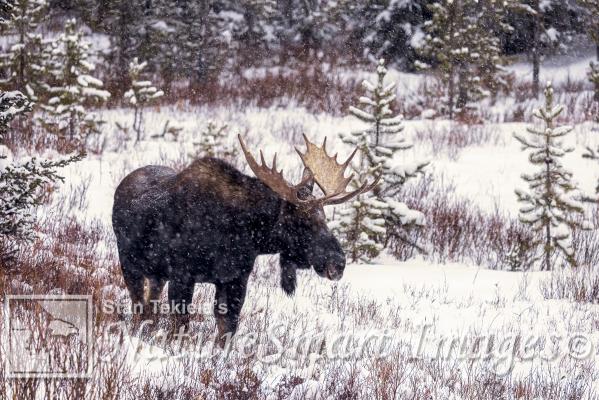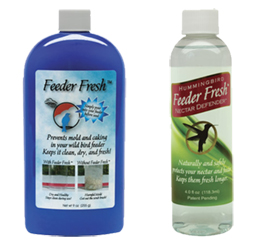View all of the titles in the
NatureSmart Bookstore

by Stan Tekiela
© NatureSmart
March 31, 2024
It was one of those dark and cloudy winter days in Yellowstone National Park where the clouds are so heavy and low, you feel like you can reach up and touch the cloudy sky. A light wind helped to blow the falling snow with occasional gusts of wind causing swirls of fluffy white snow tornados.
I had just one hour before the sunset, although in these conditions it was hard to tell the difference between the day and night. I was at about 8,000-foot elevation, which isn’t extremely high, but high enough to cause me to breathe extra hard when walking, or should I say plowing my way through the knee-deep powdery snow.
The spruce and pine trees that make up the surrounding forest were covered in a thick blanket of snow and when the wind gusted, it sent plumes of fluffy snow off the branches to the ground. A small stream snaked by in the forest. The water was moving fast enough to keep it from freezing. Next to the stream were several thick stands of willow shrub, the perfect food for the reason I was at this location, the Moose (Alces alces).
Moose are the tallest animal in North America and the second largest in overall size/mass, second only to the American Bison. The name Moose is thought to come from the Algonquin language and translate loosely to “he stirps off twigs”, or as some say, “twig eater”. This perfectly describes what these large members of the deer family eat in the winter. Small twigs, such as willow, are the main food during the winter months. This is why I was in this snowy meadow next to a creek looking for Moose.
During the daylight hours, Moose usually sit down in a covered area to rest and chew their cud. Since I couldn’t see any Moose in the area, I thought I would set myself up in the perfect habitat and wait for the Moose to become active at the end of the day. But first I needed to walk about a quarter mile through the woods to reach the open meadow. Walking in the woods wasn’t too bad but the open meadow had deeper snow making it more challenging. As I trudged through the knee-deep snow, I stopped often to catch my breath, before moving on.
While walking along the edge of the meadow, I spotted one Moose laying down. It was a bull (male) but his antlers had already fallen off. I was really hoping to find one of the bull Moose that still had their antlers. Not 20 yards later I spotted a nice big bull moose that still had its antlers. I was in luck. Now I just had to wait and see if the big boy would eventually get up before it got too dark to capture some images. I didn’t have to wait long and the big bull Moose stood up and shook the snow off its back and started to walk over to the willows.
Because of my background in wildlife biology, knowing and understanding the behaviors of the animals often gives me an edge when it comes to finding and capturing images of wildlife. Anticipating that the moose would eventually make its way to the willows, I hiked over to a slope that would give me a good view. The snow was extra deep on the downward side of the slope where the wind had blown the snow. I took a couple steps down the slope then just sat back into the snow. I was covered with snow from the waist down and I was next to a small pine tree, so I blended in perfectly. Now all I had to do was wait.
Within a few minutes both bull moose, walked into the willow stand and I was treated to unobstructed views. As I captured many images and better yet, stunning video, I could study the details of their feeding behaviors. I was close enough to hear the moose grab the ends of the willow twigs with their oversized lips and strip off the tips.
What was going through my mind was how such a large animal could first find enough to eat and also be able to obtain all the nutrients needed to survive a long harsh winter in the mountains of Wyoming on just some twigs.
I only had about 30 minutes together with the moose before it was too dark to capture any quality images. I sat in the snow for a few minutes after photographing to just watch and enjoy. I was able to slowly get up and head back to my truck. By the time I got back my truck was covered in snow, so I cleared it off and started the long hour and a half drive back to where I was staying. All in all, it was a great end to the day. Until next time…
Stan Tekiela is an author / naturalist and wildlife photographer to travels extensively to capture images of wildlife. He can be followed on www.instagram.com and www.facebook.com. He can be contacted via his website at www.naturesmart.com.
The nationally syndicated NatureSmart Column appears in over 25 cities spanning 7 states: Minnesota, Wisconsin, Michigan, Illinois, Ohio, New York and Pennsylvania. It is a bi-weekly column circulated to over 750,000 readers.
Horned Lark
The overall population of ground nesting birds is steadily going down. Here in North America, we have hundreds of bird species who nest directly on the ground. Prairie birds such as Eastern and Western Meadowlarks are a good example. If you are older than 50 you most likely remember hearing...
Sharp-tailed Grouse
The rights of spring come in many different forms, shapes, colors, and patterns. But the end goal is always exactly the same—reproduction. In nature, everything can be boiled down to one of two things, finding food to survive and mating for reproduction. It’s as simple as...
Greater Prairie Chicken
I am not a stranger to getting up at O’ dark thirty, to be able to get out and capture some images of wildlife. Over the past 40 years I would say it is definitely in the hundreds if not thousands of times I’ve dragged myself out of bed so early. So, last week when the alarm went off...
Marsh Rabbit
For me, I enjoy all aspects of nature, not just birds. I find all of nature fascinating and that is what keeps me interested. So, while leading a photo tour to Florida recently I was so excited to see a crazy cool critter that isn’t what you expect when you see it. A true rule...
Each year, during June and July, Stan Tekiela offers two world-class wildlife photography tours. Here's your chance to learn some tricks of the trade from a top professional.
View all of the titles in the
NatureSmart Bookstore
Check out Stan's latest photos at
NatureSmart Wildlife Images
Do you have any interesting wildlife in your backyard? Any nesting birds, deer, turkeys, reptiles, amphibians, or other unique wildlife? Or maybe a fox or coyote den?
If so, contact Stan at stan@naturesmart.com with your backyard wildlife. If he can get a good photo of the subject, he will send you a print of the photo to hang on your wall.
Order Prints and posters of Stan's photos at
» Prints & Posters
Hear Stan on radio stations all across the Midwest.
» More Info

When he's out in the field, Stan relies on his Vortex Razor binoculars and Vortex Razor spotting scope to help find the subjects for his award winning wildlife photography.

For thirty years, professional wildlife photographer Stan Tekiela has counted on Hunt's Photo and Video to provide him with professional photography equipment.
From tripods to camera bodies and lenses, Hunt's has been Stan's place for everything that he needs. Personal service and prompt shipping means Stan can count on Hunt's to support his professional wildlife photography career.


Professional Wildlife Photographer Stan Tekiela always uses Feeder Fresh in his seed feeders to help keep the feeders and food dry, clean and mold free.
He also uses Feeder Fresh Nectar Defender in all of his hummingbird feeders. It safely keeps nectar fresh longer.